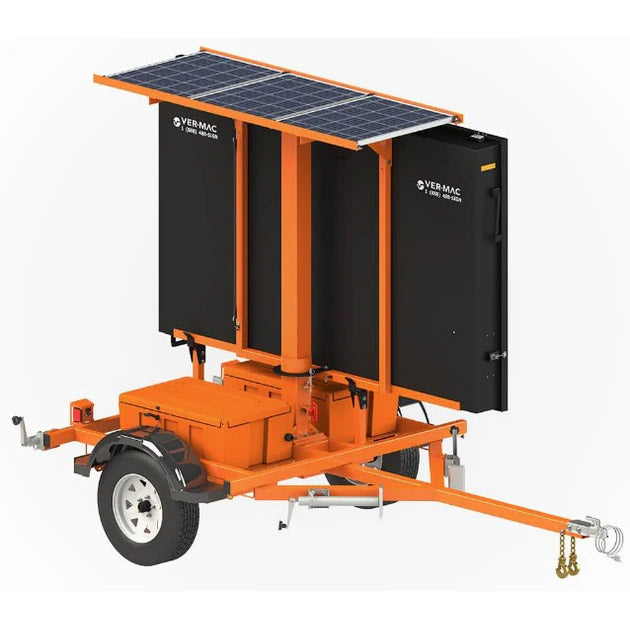
Jersey Barricades: How They Add Impact Absorption
When we think of barriers on roads or worksites, we often picture rigid concrete walls or heavy metal guardrails. But over recent decades, water-filled jersey barricades—also known as jersey wall barriers—have become increasingly popular.
Why? Because they blend portability with surprising energy-absorbing power, making them ideal for modern traffic control needs. In this blog, we'll dive into how these barriers work, how they’ve evolved, and why traffic control companies now favor them for safety, flexibility, and impact mitigation.
The Basics: What Are Water-Filled Jersey Barricades?

Water-filled jersey barricades are hollow, durable plastic structures designed to be transported empty and then filled with water or sometimes sand at the worksite. Once filled, they gain mass and rigidity, allowing them to perform like heavier, more permanent barriers—but with much greater flexibility.
They interlock or align side by side to form continuous lines—creating what’s often called a “jersey wall.” Designers often add features such as reflective strips, high-visibility coloring, and recessed channels for lights or signage. The modular design allows segments to be rearranged, replaced, or extended as jobsite conditions change.
One of their most valuable qualities is impact absorption: in the event a vehicle collides with them, they absorb energy and reduce damage compared to a rigid barrier. This is what makes them especially useful in traffic control setups where vehicle interactions are possible.
The Physics of Impact Absorption

To understand why water-filled barriers work, you must consider basic energy dynamics. In a collision, a moving vehicle carries kinetic energy proportional to its mass and the square of its speed. A rigid barrier transfers most of that energy back into the vehicle or its contents. That means more damage, more danger, and greater risk to occupants.
Water-filled barriers act like a buffer. As a collision occurs, some of that energy is used to shift or deform the barrier slightly. The water inside can move and dissipate energy gradually rather than suddenly.
The barrier may flex or shift within its base, dissipating force. In practical settings, this means less damage to both the barrier and the vehicle (especially light-duty ones), and increased protection for people inside.
Because these barriers are not brittle, they tend to avoid catastrophic failure—no sudden shattering or complete collapse. In many cases, they can be repositioned, refilled, and reused after an impact that would severely damage a rigid barrier. That durability, combined with absorption, is a key reason many traffic control companies prefer them.
How Jersey Barricade Evolved Over Time

Early barriers were heavy and permanent. You’d see concrete or steel walls in major highway or bridge projects. But those were costly to install, difficult to modify, and often introduced themselves as hazards where traffic patterns or construction plans changed.
The evolution toward plastic, modular, water-filled barriers began in response to the need for temporary traffic control, adaptivity, and speed of deployment. As material science improved, so did the strength and weather resilience of plastic barriers. Manufacturers introduced UV-resistant materials, stronger interlocking systems, and optimized shapes that distribute forces more effectively.
Today’s jersey barricades integrate reflective surfaces and channels for warning lights. Some models include sacrificial sections that can break away in a controlled way under extreme impact, preserving the rest of the barrier. These innovations help balance flexibility, durability, and traffic safety.
In a similar vein, signage strategies have evolved parallel to barriers. Modern parking signs, for example, now often include reflective surfaces, dynamic inserts, and modular mounting systems that match the flexibility of contemporary barriers. The synergy between good signage and adaptive barriers marks how traffic control is shifting toward systems rather than isolated devices.
Use in Construction Zones and Highway Work

One of the most common environments for water-filled jersey barricades is highway or road construction zones. Here, changing lane patterns, shifting shoulder work, and variable traffic speeds all require a barrier system that can adapt. These barriers help:
-
Maintain a clear, continuous line between active lanes and workers.
-
Provide a buffer zone where errant vehicles may impact the barrier instead of entering the work area.
-
Improve visual clarity, especially with reflective strips or warning lights embedded in the barrier surface.
Because they are portable, crews can reposition them nightly—or even hourly—without shutting down entire lanes. For long-term highway or infrastructure projects, barricades provide a middle ground between rigid permanent walls and fragile cones.
In rolling work zones, where the construction area moves forward gradually, water-filled barriers lend themselves well to staging. Sections of the wall can be moved ahead and refilled without dismantling the whole setup, ensuring continuous protection along the changing jobsite edge.
Use at Events, Concerts, and Sports Facilities

Large gatherings, festivals, stadium entrances, and outdoor concerts all involve heavy vehicle and pedestrian traffic. Where traffic patterns may shift over the course of a day or between events, flexibility in barriers becomes critical.
Water-filled jersey barricades are used to:
-
Define parking lots and event perimeters.
-
Separate pedestrian walkways from vehicle zones.
-
Secure backstage, delivery, or restricted access lanes.
-
Create emergency corridors or evacuation paths.
-
Adjust configurations dynamically as crowd flow changes.
Because they can be empty during transport and then filled on-site, they reduce logistical costs for loading, shipping, and setup. When the event is over, water is drained and units are removed with ease. For sports venues, these barriers help manage parking ingress/egress, fan flow, and vehicle staging for game day logistics.
Urban and Mixed Traffic Applications

In city streets, where space is tight and road layouts may change due to utilities or maintenance, water-filled jersey walls offer a flexible solution. They help with:
-
Temporary lane realignments or diversions.
-
Protecting pedestrian work zones during sidewalk upgrades or street repairs.
-
Shielding active construction edges near curbs or building fronts.
-
Managing public works operations without permanent infrastructure disruption.
Because of their modular and movable nature, they are especially suited to public works projects that require short-term closures or shifting zones. The added benefit is they maintain a uniform look and continuity, increasing driver and pedestrian recognition of a controlled zone.
Maintenance, Durability, and Lifecycle

A major advantage of these barriers lies in their longevity and reusability. Once a unit is cracked or damaged, many sections can be replaced individually rather than discarding the whole barrier. Their UV-resistant plastics resist fading, and proper maintenance (cleaning, sealing joints, checking fill caps) helps extend lifespan.
In many cases, a barrier impacted in a low-speed event can be drained, realigned, and reused in the same or another zone. This reduces long-term cost and waste. For large-scale traffic control operations, budgeting on reusability is a key benefit.
Integration with Traffic Control Strategies

These barricades should not be used in isolation. For best results, they form one component in a holistic traffic control plan. Cones, signage, personnel, message boards, and flagging devices all work together with jersey walls to create safe, predictable traffic environments.
A strong traffic management plan will consider barrier placement, criteria for maximum impact zones, separation from live traffic, pedestrian access, and emergency passage. Many traffic control companies now run simulations or use standards such as the Ontario Traffic Manual to design appropriate configurations using these barriers.
Barrier selection should vary based on vehicle speed, proximity to work zones, expected loads, and the type of traffic (cars, heavy trucks, motorcycles). Well-placed jersey walls help ensure safety, absorb impacts, and maintain separation without becoming a hazard themselves.
Challenges and Considerations

While water-filled jersey barricades offer tremendous advantages, they are not perfect for every scenario. Some challenges include:
-
Fill water requirements and maintenance (avoiding leaks, freeze risk in cold climates).
-
The barriers may still allow slower, lighter vehicles to override sections in collisions.
-
Proper base preparation is needed to maintain alignment and prevent shifting over time.
-
Very high-speed collision zones may still prefer rigid alternatives, depending on regulation and liability.
Understanding these limitations helps traffic control companies choose the right barrier type for a given traffic control project.
________
Water-filled jersey wall systems offer a powerful blend of adaptability, visibility, and impact absorption. They represent the modern evolution of protective barriers in traffic control, where flexibility and safety must co-exist. When used thoughtfully within a traffic management plan, they protect workers, guide drivers, and absorb crashes more gracefully than rigid options.
Safety on our roads and work zones depends on tools that respond intelligently to changing conditions. For dependable, high-performance jersey wall barriers and related attenuators, trust Barricade Traffic Services. Their inventory, experience, and commitment to safety give you peace of mind—because in traffic control, every barrier counts.




